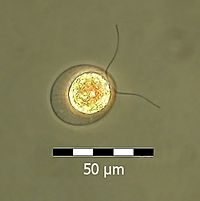Chlorophyta facts for kids

Chlorophyta are a division of green algae.
It includes about 7,000 species of mostly aquatic photosynthetic eukaryote organisms.
Like the land plants, green algae contain chlorophylls a and b, and store food as starch in their plastids. Most species are flagellate in at least one stage of their life cycle.
They are related to the Charophyceae (also called Charophyta) and land plants, together making up the Viridiplantae.
The division contains both unicellular and multicellular species. While most species live in freshwater habitats and a large number in marine habitats, other species are adapted to a wide range of environments. Watermelon snow, or Chlamydomonas nivalis, lives on summer alpine snowfields. Others live attached to rocks or woody parts of trees. Some lichens are symbiotic relationships between fungi and green algae.
Members of the Chlorophyta also form symbiotic relationships with protozoa, sponges and cnidarians. Some conduct sexual reproduction.
Images for kids
-
Green algae on coastal rocks at Shihtiping in Taiwan
-
"Siphoneae" from Ernst Haeckel's Kunstformen der Natur, 1904
See also
 In Spanish: Clorófitas para niños
In Spanish: Clorófitas para niños




